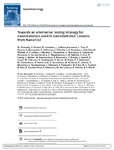Towards an alternative testing strategy for nanomaterials used in nanomedicine: Lessons from NanoTEST
| dc.contributor.author | Dusinska, M | |
| dc.contributor.author | Boland, S | |
| dc.contributor.author | Saunders, M | |
| dc.contributor.author | Juillerat-Jeanneret, L | |
| dc.contributor.author | Tran, L | |
| dc.contributor.author | Pojana, G | |
| dc.contributor.author | Marcomini, A | |
| dc.contributor.author | Volkovova, K | |
| dc.contributor.author | Tulinska, J | |
| dc.contributor.author | Knudsen, LE | |
| dc.contributor.author | Gombau, L | |
| dc.contributor.author | Whelan, M | |
| dc.contributor.author | Collins, AR | |
| dc.contributor.author | Marano, F | |
| dc.contributor.author | Housiadas, C | |
| dc.contributor.author | Bilanicova, D | |
| dc.contributor.author | Halamoda Kenzaoui, B | |
| dc.contributor.author | Correia Carreira, S | |
| dc.contributor.author | Magdolenova, Z | |
| dc.contributor.author | Fjellsbø, LM | |
| dc.contributor.author | Huk, A | |
| dc.contributor.author | Handy, Richard | |
| dc.contributor.author | Walker, L | |
| dc.contributor.author | Barancokova, M | |
| dc.contributor.author | Bartonova, A | |
| dc.contributor.author | Burello, E | |
| dc.contributor.author | Castell, J | |
| dc.contributor.author | Cowie, H | |
| dc.contributor.author | Drlickova, M | |
| dc.contributor.author | Guadagnini, R | |
| dc.contributor.author | Harris, G | |
| dc.contributor.author | Harju, M | |
| dc.contributor.author | Heimstad, ES | |
| dc.contributor.author | Hurbankova, M | |
| dc.contributor.author | Kazimirova, A | |
| dc.contributor.author | Kovacikova, Z | |
| dc.contributor.author | Kuricova, M | |
| dc.contributor.author | Liskova, A | |
| dc.contributor.author | Milcamps, A | |
| dc.contributor.author | Neubauerova, E | |
| dc.contributor.author | Palosaari, T | |
| dc.contributor.author | Papazafiri, P | |
| dc.contributor.author | Pilou, M | |
| dc.contributor.author | Poulsen, MS | |
| dc.contributor.author | Ross, B | |
| dc.contributor.author | Runden-Pran, E | |
| dc.contributor.author | Sebekova, K | |
| dc.contributor.author | Staruchova, M | |
| dc.contributor.author | Vallotto, D | |
| dc.contributor.author | Worth, A | |
| dc.date.accessioned | 2016-06-22T15:55:56Z | |
| dc.date.available | 2016-06-22T15:55:56Z | |
| dc.date.issued | 2015-05-25 | |
| dc.identifier.issn | 1743-5390 | |
| dc.identifier.issn | 1743-5404 | |
| dc.identifier.uri | http://hdl.handle.net/10026.1/4942 | |
| dc.description.abstract |
In spite of recent advances in describing the health outcomes of exposure to nanoparticles (NPs), it still remains unclear how exactly NPs interact with their cellular targets. Size, surface, mass, geometry, and composition may all play a beneficial role as well as causing toxicity. Concerns of scientists, politicians and the public about potential health hazards associated with NPs need to be answered. With the variety of exposure routes available, there is potential for NPs to reach every organ in the body but we know little about the impact this might have. The main objective of the FP7 NanoTEST project ( www.nanotest-fp7.eu ) was a better understanding of mechanisms of interactions of NPs employed in nanomedicine with cells, tissues and organs and to address critical issues relating to toxicity testing especially with respect to alternatives to tests on animals. Here we describe an approach towards alternative testing strategies for hazard and risk assessment of nanomaterials, highlighting the adaptation of standard methods demanded by the special physicochemical features of nanomaterials and bioavailability studies. The work has assessed a broad range of toxicity tests, cell models and NP types and concentrations taking into account the inherent impact of NP properties and the effects of changes in experimental conditions using well-characterized NPs. The results of the studies have been used to generate recommendations for a suitable and robust testing strategy which can be applied to new medical NPs as they are developed. | |
| dc.format.extent | 118-132 | |
| dc.format.medium | ||
| dc.language | en | |
| dc.language.iso | eng | |
| dc.publisher | Informa UK Limited | |
| dc.subject | Hazard assessment | |
| dc.subject | in vitro | |
| dc.subject | nanoparticles | |
| dc.subject | NanoTEST | |
| dc.subject | testing strategy | |
| dc.title | Towards an alternative testing strategy for nanomaterials used in nanomedicine: Lessons from NanoTEST | |
| dc.type | journal-article | |
| dc.type | Journal Article | |
| dc.type | Research Support, Non-U.S. Gov't | |
| dc.type | Review | |
| plymouth.author-url | https://www.webofscience.com/api/gateway?GWVersion=2&SrcApp=PARTNER_APP&SrcAuth=LinksAMR&KeyUT=WOS:000353926200014&DestLinkType=FullRecord&DestApp=ALL_WOS&UsrCustomerID=11bb513d99f797142bcfeffcc58ea008 | |
| plymouth.issue | sup1 | |
| plymouth.volume | 9 | |
| plymouth.publication-status | Published | |
| plymouth.journal | Nanotoxicology | |
| dc.identifier.doi | 10.3109/17435390.2014.991431 | |
| plymouth.organisational-group | /Plymouth | |
| plymouth.organisational-group | /Plymouth/Faculty of Science and Engineering | |
| plymouth.organisational-group | /Plymouth/Faculty of Science and Engineering/School of Biological and Marine Sciences | |
| plymouth.organisational-group | /Plymouth/REF 2021 Researchers by UoA | |
| plymouth.organisational-group | /Plymouth/REF 2021 Researchers by UoA/UoA06 Agriculture, Veterinary and Food Science | |
| plymouth.organisational-group | /Plymouth/Research Groups | |
| plymouth.organisational-group | /Plymouth/Research Groups/Marine Institute | |
| plymouth.organisational-group | /Plymouth/Users by role | |
| plymouth.organisational-group | /Plymouth/Users by role/Academics | |
| dc.publisher.place | England | |
| dc.identifier.eissn | 1743-5404 | |
| dc.rights.embargoperiod | Not known | |
| rioxxterms.versionofrecord | 10.3109/17435390.2014.991431 | |
| rioxxterms.licenseref.uri | http://www.rioxx.net/licenses/all-rights-reserved | |
| rioxxterms.type | Journal Article/Review |


